Southeastern Insights
March 2015
Southeastern Insights provides a broad summary of economic intelligence gathered through our network of business contacts and other sources throughout the Southeast during the latest Federal Open Market Committee (FOMC) cycle. This report covers the period from January 29 to March 18.
General business conditions
The majority of contacts report that business conditions continue to improve at a steady pace and the economy is on a positive path. However, a common theme this cycle is the continued widening divergence of contact reports on economic conditions and sentiment between Florida and the rest of the District. Both Jacksonville and Miami contacts report accelerating economic activity and continue to be increasingly upbeat with respect to the outlook for 2015. Other District areas continue to note a mildly positive short-term outlook, similar to previous cycles. Some of the recent divergence may be explained by the severe winter weather experienced across much of the nation and the Southeast (except for Florida, of course) in February, with virtually all retail contacts reporting negative impacts. Some retailers reported missing key sales dates such as President's Day due to the harsh weather.
The Atlanta Fed's Construction and Real Estate survey also indicated weather played a factor in suppressing activity. Many builders reported that construction activity was down from the year-earlier level. While many builders and brokers reported that home sales were flat to slightly up in February from the year-earlier level, several contacts indicated weaker sales activity. These contacts attributed stalled demand and a "slump" to harsh weather and concerns about government such as spending, taxes, and health insurance.
Regional manufacturing activity has been gaining strength since December, according to Kennesaw State University's Southeast Purchasing Managers Index (PMI). After falling to 45.6 in December, the PMI increased to 55.6 in January and 60.5 in February. A reading above 50 indicates that overall manufacturing activity in the region has expanded (see chart 1).
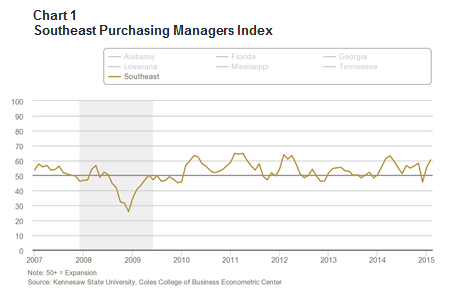
Employment/labor markets
Business contacts provided mixed reports on the labor market. Some contacts state they have had little difficulty finding workers at the lower end of the skill spectrum (minimum wage retail or service jobs), and there are more than enough applicants seeking those types of positions. On the other hand, other industries continue to report difficulty filling positions that require a higher skill set. Over the past 18 months, the list of difficult-to-fill jobs has grown notably, from truck drivers, engineers, information technology professionals, and some craft workers to accountants, maintenance technicians, skilled craft workers, middle management, and other midlevel positions. The growing list reiterates the continued trend of labor market tightness in the midst of a declining qualified applicant pool.
Another common theme among contacts this cycle involved challenges they face with increasing turnover. Firms have had to make additional efforts to retain existing staff. When faced with replacing workers, many contacts report that it takes more time than it did a year ago and to obtain high-quality, experienced people they have to recruit qualified workers away from jobs at other firms.
Despite these challenges, payroll employment for the District continues to increase month over month and the District states added 17,300 net jobs in January (see chart 2).
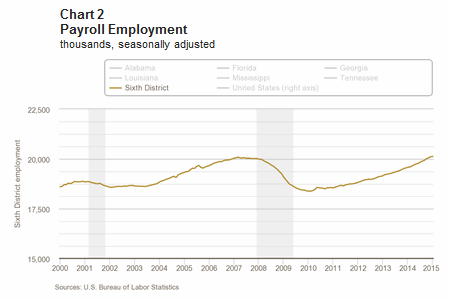
Wages and input prices
Generally, there were not many reports of wage pressure outside of high-demand and specialized skill positions. When contacts mentioned increases, they were typically in the range of 2 to 3 percent, consistent with previous cycles. This trend in the Sixth District remains similar to the national picture where wage growth has failed to show much of an upward trend (see chart 3).
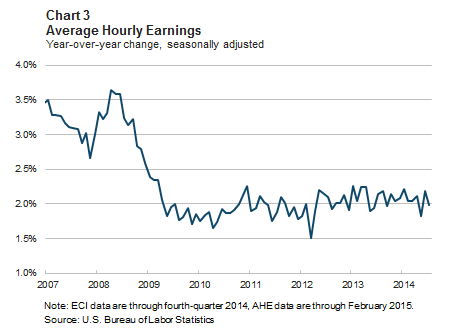
For the most part, firms indicate they do not have pricing power and there was very little mention of increasing prices. The decrease in energy prices and some raw materials has provided a welcome boost to margins, with only a few isolated instances of cost savings being passed on with price reductions. Although these contacts expressed that they do not feel prices will increase in the short term, respondents to the Atlanta Fed's latest business inflation expectations (BIE) survey indicated that, on average, they expect unit costs to rise 1.7 percent over the next 12 months (see chart 4). The BIE survey results began trending downward at the end of last year and have remained flat since the start of the year. This survey was created to measure the year-ahead inflationary sentiments of businesses in the Sixth District.
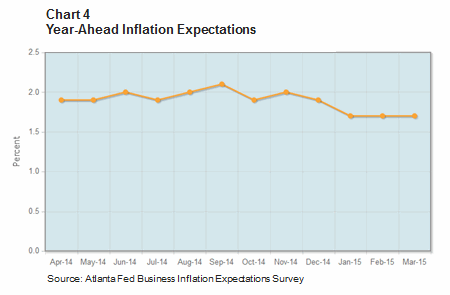
Credit and investment
Businesses continue to report that credit is readily available. Banks noted stronger growth in small business lending, which is supported by small businesses also reporting more credit availability. Reports indicate that businesses are borrowing in anticipation of a rising rate environment and taking advantage of the opportunity to obtain "cheap" money. Companies are doing several things with the new borrowings such as dividends to shareholders, acquisition opportunities, increased capital expenditures, and market expansion. Banks and businesses also report that credit terms are more liberal in the broader market. According to the Federal Reserve Board, national lending activity in commercial banks rose in all categories except consumer loans in January (see chart 5).
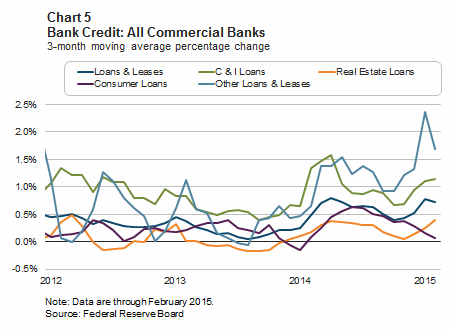
Capital investments seem to be part of the business strategies for a number of contacts, though the spend rate for companies affected by the decline in oil prices has slowed. For the first time, we are hearing that retail contacts are looking at expanding, noting more confidence and evidence of consumer spending.
Business outlook
The outlook for the rate of business growth over the next three to six months remains optimistic for most of our directors and contacts. Nearly all Sixth District directors believe that economic growth will remain the same or higher in the short term (see chart 6).
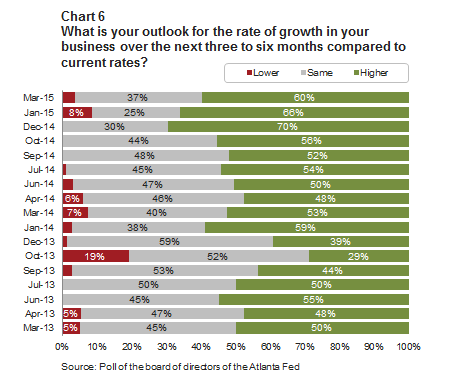
The medium-term outlook for business growth remains positive for our directors and contacts. For the first time since we began tracking their sentiment, all the directors indicate that they expect growth over the medium term either to be the same or higher than current rates (see chart 7).
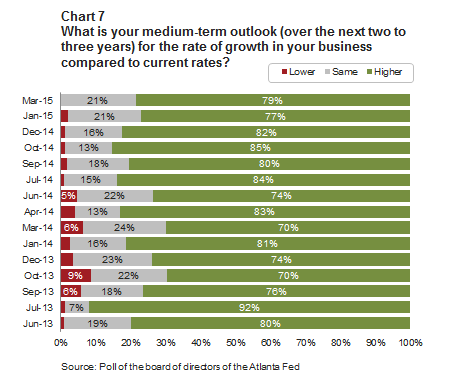
In conclusion, the view from business contacts indicates that the southeastern economy continues to improve. We will keep watching closely for signs that the optimism expressed translates into additional economic activity and growth.



